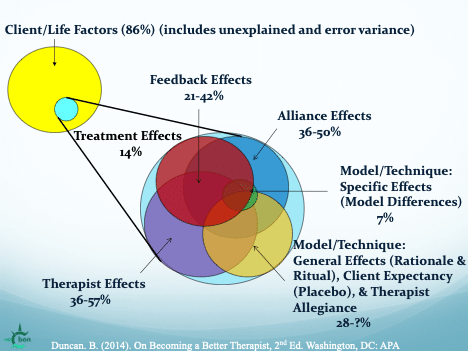Stop Chasing Theories—Start Following Your Clients

What Really Makes Therapy Work? (Hint: It’s Not What You’re Told on Facebook)
If you’re a therapist, you’ve probably been taught that mastering the right model or technique is the key to successful outcomes. But here’s the inconvenient truth—one backed by decades of research and the findings I’ve laid out in many publications, starting with our 1994 article, Applying Outcome Research: Most of therapy’s success has nothing to do with your favorite theory.
In fact, as Michael Lambert’s early review reports:
- 40% of change comes from clients’ own resources and life outside therapy
- 30% comes the alliance, including relational qualities like empathy, respect, and genuineness
- Only 15% comes from your technique
- And 15% comes from placebo and expectancy effects
But the science is even more radical than Lambert reported. Meta-analysis reveals a dramatic 86% of change arises from what clients bring to the endeavor while the alliance accounts for nearly half of the effects of any treatment administered (see figure below) Although overlapping with the alliance, the person of the therapist accounts for about half as well. And sorry model maniacs, model differences make up only about 7% of the effects of therapy.

So why are we still trying to squeeze clients into theoretical boxes?
The Takeaway: Therapy Works Best When It’s Client-Directed
The real magic happens when therapists intentionally step into the client’s frame of reference, their theory of change—when we let clients define what matters, how therapy helps, and how change happens. When clients feel understood, validated, and empowered, outcomes improve.
When we join their world instead of trying to fit them into ours, therapy works better.
5 Simple Ways to Apply This Starting Now
Make the Client the Expert
Start by validating their distress—No wonder you are experiencing ______given x, y, and z. Demonstrate that you understand the context of their life circumstance, that you are on their side.
- Ask about their goals in their own words
- Respect their explanation of what’s happening and what might help (don’t be the reality police)
- Your belief in their capacity for change is contagious.
- Frame interventions as ways to tap into their strengths
- Resist the urge to translate their story into your theory
Learn the Client’s Theory of Change
Adopt their views in their terms with a very strong bias in their favor. Explore the client’s thoughts, feelings, and attitudes about the nature of the problem as well as all ideas about how you might best address the client’s goals.
- Make direct inquiries about the client’s goals and ideas about change:
Many times, people have a pretty good hunch about not only what is causing a problem, but also what will resolve it. Do you have a theory of how change will happen here?
Align with Their Experience of the Relationship
It’s not about whether you think you’re empathic—it’s whether they feel it. Not everyone experiences empathy as their affective experience. Many, for example, experience empathy via a cognitive understanding of their dilemma.
- Check in regularly about how they experience you
- Adjust based on their feedback
- Stay curious, not defensive
- This is, of course, what PCOMS and the Session Rating Scale are all about
Flex Your Approach—Not Your Clients
Your style, interventions, and language should fit them—not the other way around.
- Adapt your methods to each client’s unique perspective
- Be willing to drop techniques that don’t resonate
- Keep the focus on connection, not intervention from your model
- Use the Outcome Rating Scale to ensure clients are benefiting and if not, collaborate to find a different path
Let Collaboration Drive the Process
Real collaboration means co-creating therapy—together.
- Define goals jointly
- Develop interventions jointly
- Be ready to pivot when clients need something different, when they are not benefitting (This is what PCOMS and the ORS bring to the therapy table.)
Why This Matters—For You and Your Clients
When you adopt a client-directed, relationship-first approach, you’ll notice:
✅ Stronger alliances
✅ Higher client engagement
✅ Quicker breakthroughs on what really matters
✅ Better, longer-lasting outcomes
And here’s the bonus: You’ll feel more energized, less burned out, and more connected to the work. Creating a theory and way of working with each client is not only a lot more interesting and fun, but it also helps you grow as a therapist throughout your career.
Final Thought
The outcome research is clear—and has been for decades. It’s time we stopped chasing models and started following our clients. When we let them lead, therapy stops being a guessing game—and starts being the powerful partnership it’s meant to be.
